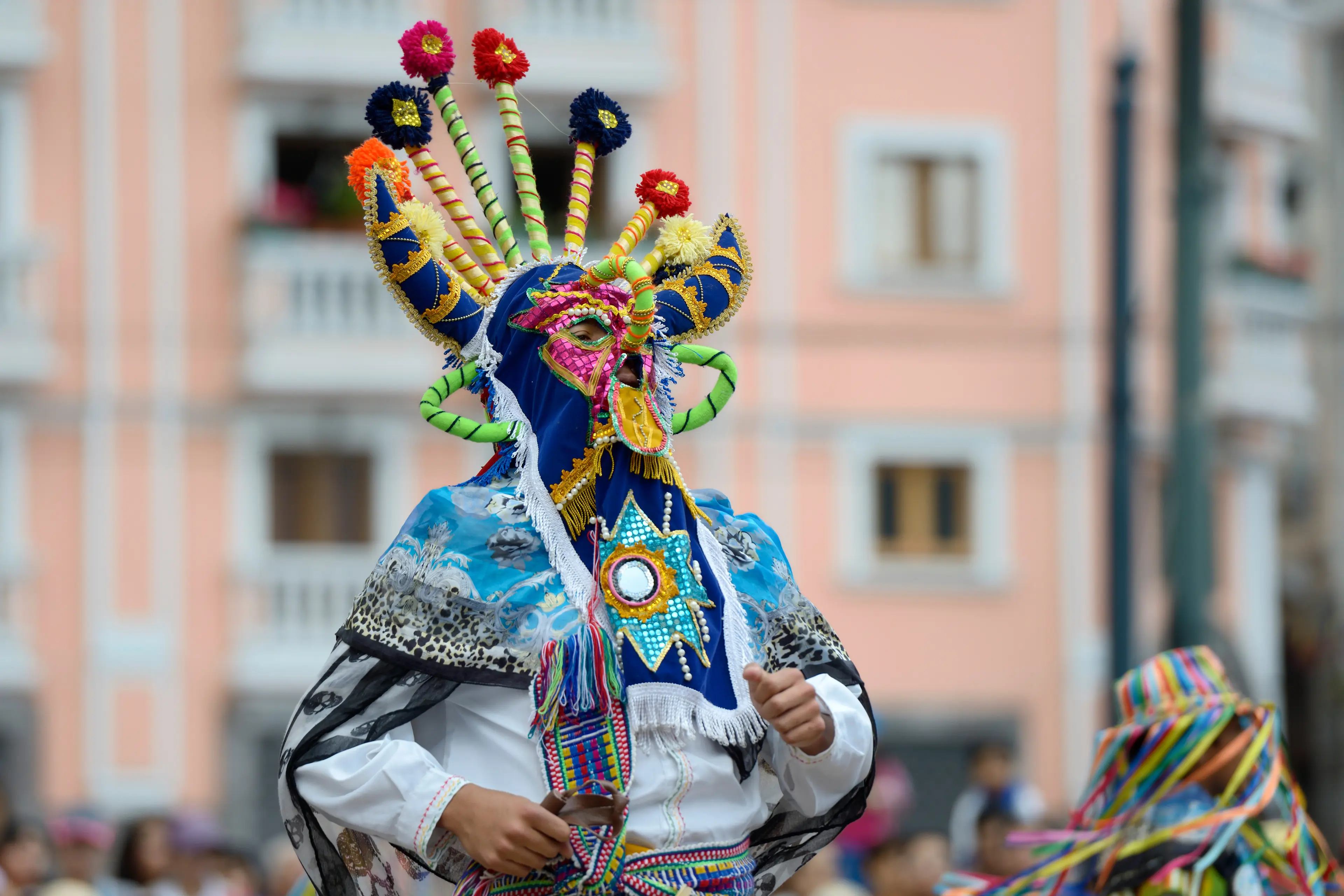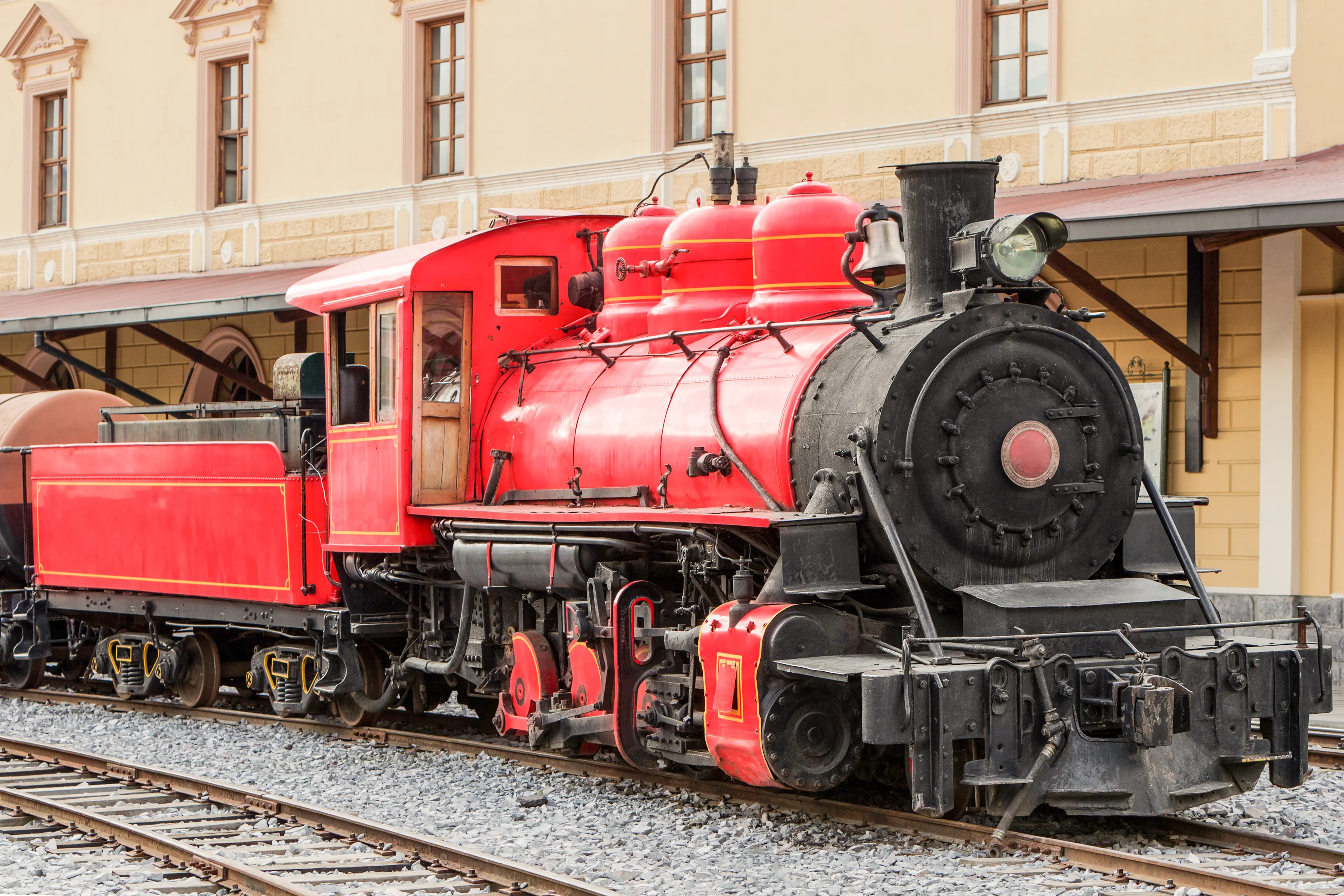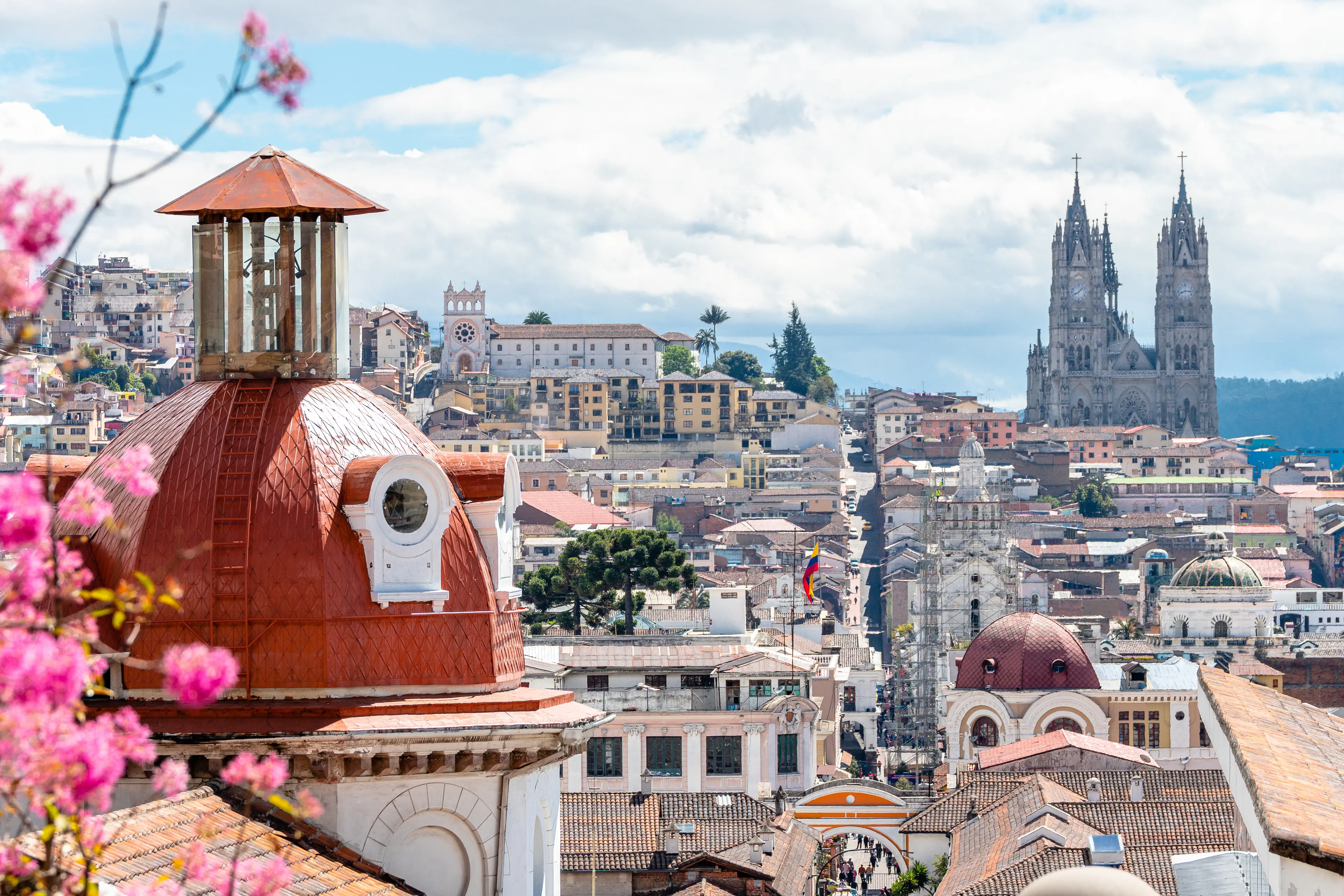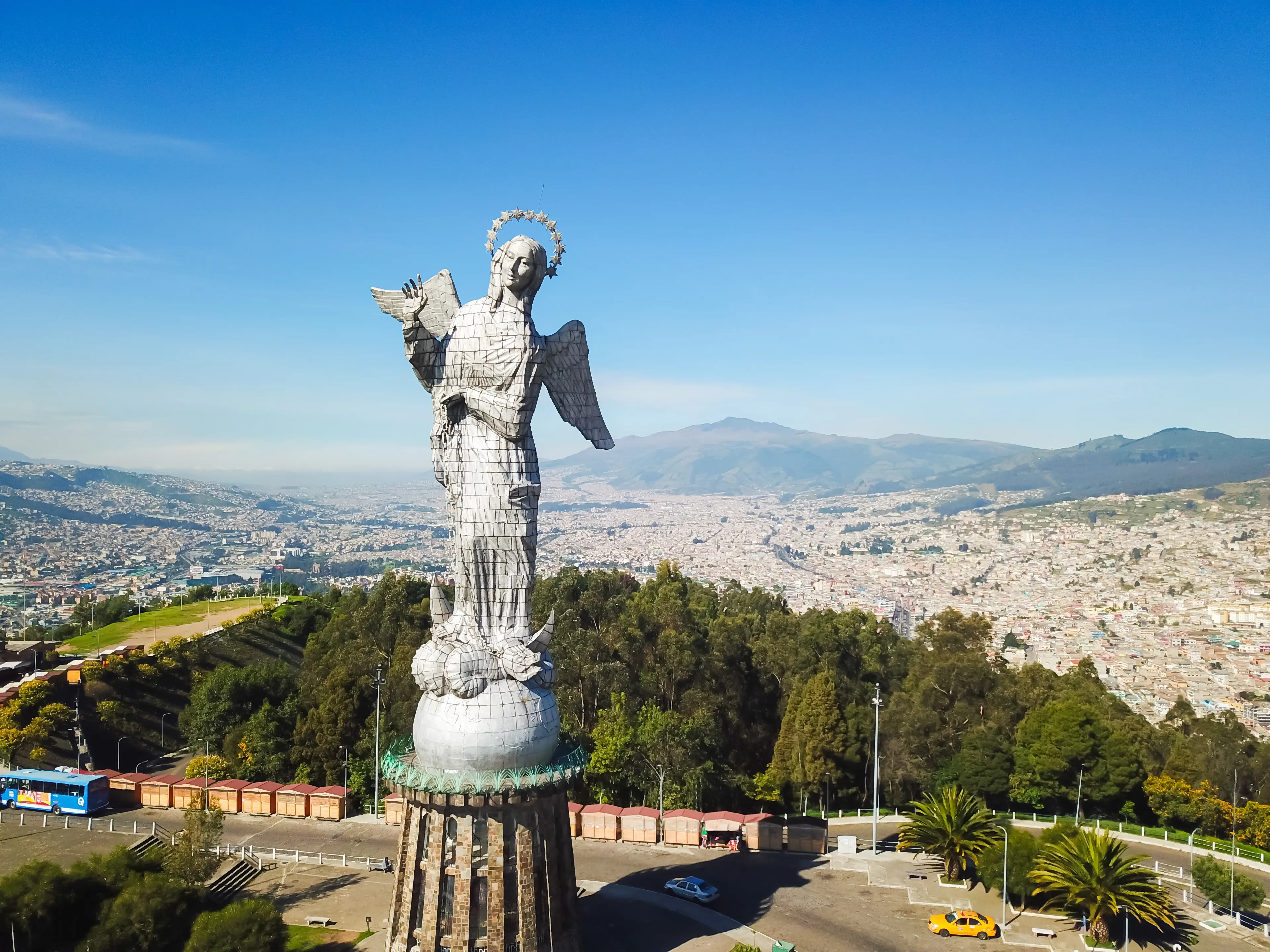3-Day Quito Adventure: Nightlife & Unexplored Paths with Friends
Quito, Ecuador
3 days





About Quito, Ecuador
Discover the charm of Quito, Ecuador, a UNESCO World Heritage site nestled high in the Andes. This vibrant city offers a unique blend of modern cosmopolitan life and rich history. Explore the well-preserved colonial center with its stunning monasteries, cathedrals, and colorful markets. Visit the iconic Panecillo hill for panoramic views or venture to the nearby Cotopaxi National Park for breathtaking landscapes and adventure activities. Indulge in local cuisine, featuring traditional dishes like ceviche and guinea pig. With its pleasant climate, friendly locals, and diverse attractions, Quito provides an unforgettable travel experience. Whether you're a history buff, nature lover, or foodie, Quito, Ecuador has something for everyone.
3-Day Itinerary
Day 2
Adventure in the Mindo Cloud Forest
Morning
Embark on an adventure to the Mindo Cloud Forest, a biodiversity hotspot. Go bird watching, hiking, or zip-lining.
Lunch
Have a picnic lunch amidst the lush greenery of the cloud forest. Don't forget to try some of the locally grown coffee.
Afternoon
Continue exploring the cloud forest. Visit a butterfly farm or a chocolate factory, or take a refreshing dip in a natural waterfall.
Dinner
Dine at a restaurant with a view of the surrounding mountains. Try a hearty locro de papa, a traditional potato soup.
Evening
Relax at a local pub with live music, or take a night walk in the forest to spot nocturnal wildlife.
Day 3
Standing on the Equator and Ascending the Pichincha Volcano
Morning
Visit the Middle of the World Monument, where you can stand on the equator. Explore the surrounding park and museum.
Lunch
Enjoy a meal at a local restaurant. Try a traditional Ecuadorian almuerzo, a set lunch menu that changes daily.
Afternoon
Take a cable car ride up to the Pichincha Volcano for breathtaking views of Quito and the surrounding Andes.
Dinner
Have dinner at a restaurant with panoramic views of the city. Try a traditional Ecuadorian dish like seco de chivo, a goat stew.
Evening
End your trip with a visit to a local salsa club in the Mariscal District. Dance the night away or simply enjoy the vibrant atmosphere.
Attractions in Itinerary (6)

1Old Town
The historic center of Quito, filled with colonial architecture, cultural experiences, and many attractions.

2La Floresta
A bohemian neighborhood known for its food scene, cultural activities, and street art.

3Mariscal District
A vibrant neighborhood known for its restaurants, bars, and nightlife.

4Mindo Cloud Forest
A biodiversity hotspot and a birdwatcher's paradise, Mindo Cloud Forest is one of the most famous attractions in Ecuador. It offers a range of activities such as hiking, bird watching, and orchid spotting. The forest is home to hundreds of species of birds and butterflies.

5Middle of the World Monument
A monument marking the equator, with a museum about indigenous cultures.

6Pichincha Volcano
An active stratovolcano in the country. It's two highest peaks are a popular spot for hiking.
Local Food and Drinks (12)

Ceviche
A popular dish in coastal regions of Latin America, particularly in Quito, Ecuador. It is typically made from fresh raw fish cured in citrus juices, such as lemon or lime, and spiced with chili peppers, onions, and cilantro.

Locro de Papa
A rich, hearty potato soup that is a traditional Ecuadorian dish. It's typically served with avocado and cheese, making it a staple comfort food in Quito.

Hornado
A traditional Ecuadorian dish, particularly popular in Quito. It is a slow-roasted pork dish usually served with potatoes and corn.

Empanadas de Viento
These are Ecuadorian cheese empanadas that are fried until crispy and served sprinkled with sugar. They are a popular snack in Quito.

Seco de Chivo
A traditional Ecuadorian stew made with goat meat, although it can also be made with beef or chicken. It is a popular dish in Quito, often served with rice and fried plantains.

Encebollado
A fish soup that is considered a national dish of Ecuador. It is particularly popular in Quito, where it is often eaten as a hangover cure.

Canelazo
A traditional Andean drink made from aguardiente (a sugar cane alcohol), sugar, and water boiled with cinnamon. It is particularly popular in Qito during the colder months.

Guatita
A traditional Ecuadorian dish made from potatoes and tripe stewed in a peanut sauce. It is a popular comfort food in Quito.

Churrasco Ecuatoriano
A traditional Ecuadorian dish consisting of a grilled steak, served with a fried egg, rice, fries, salad, and ripe plantains. It is a popular dish in Quito.

Morcilla
A type of blood sausage that is a popular food in Quito. It is often served grilled with a side of potatoes.

Chicha de Jora
A traditional Andean drink made from fermented corn. It is a popular drink in Qito, often consumed during festivals and celebrations.

Tortillas de Maíz
These are traditional Ecuadorian corn tortillas. They are a staple food in Quito, often served with meals or used to make empanadas.
Best time to visit
The best time to visit Quito, Ecuador is during the dry season, which runs from June to September. During these months, you can expect less rainfall and clearer skies, making it ideal for outdoor activities and sightseeing. However, Quito has a fairly consistent climate year-round due to its location on the equator, so it's possible to enjoy your visit at any time of the year. Just keep in mind that the city is located at a high altitude, so the sun can be quite strong despite the cooler temperatures.
How to get around
Public Bus
Quito's public bus system is extensive and covers most areas of the city. Buses run frequently and are a cost-effective way to get around. However, they can be crowded during peak hours and may not be the most comfortable option.
Taxi
Taxis are plentiful in Qito and can be hailed from the street, called by phone, or booked through a hotel. They are metered, so the fare is determined by the distance traveled. Taxis are a convenient and relatively inexpensive way to get around.
Private Car Hire
Private car hires, or chauffeur services, are available in Quito. This can be a more comfortable and convenient option, especially for longer trips or for those who prefer not to navigate Quito's busy streets themselves.
Ridesharing
Ridesharing services, such as Uber, are available in Quito. This can be a convenient option, as you can book and pay for your ride through the app. However, availability can vary depending on the time and location.
Bicycle
Quito is a bike-friendly city with many dedicated bike lanes and bike rental services. Cycling can be a fun and eco-friendly way to explore the city. However, be aware that Quito's hilly terrain and high altitude can make cycling more challenging.
Foot
Many of Quito's attractions are located in the city center, which is compact and walkable. Walking is a great way to explore the city at your own pace, but be aware that Quito's high altitude can make physical exertion more tiring.
Car Rental
Renting a car can give you the flexibility to explore Qito and the surrounding areas at your own pace. However, driving in Quito can be challenging due to heavy traffic, narrow streets, and aggressive driving habits of some locals.
Tram
Quito's tram system, known as the Metrovia, is a modern and efficient way to get around. It covers several key areas of the city and runs frequently. However, it can be crowded during peak hours.
Tour Bus
Several companies operate tour buses in Qito, offering hop-on hop-off services that cover major tourist attractions. This can be a convenient way to see the sights, especially for first-time visitors.
Important information
Currency$ USD
Time zoneUTC-5
Driving sideRight
Emergency phoneAmbulance: 131; Fire: 102; Police: 101
Drinking waterOpt for bottled water
Power sockets
Voltage120 V
Things to know about Quito, Ecuador as a first time visitor
1
Quito is located at a high altitude (around 9,350 feet or 2,850 meters), so it's common to experience altitude sickness. Take it easy for the first few days to acclimate.
2
The currency in Ecuador is the U.S. dollar, so there's no need to exchange money if you're coming from the United States.
3
Quito has a fairly consistent climate year-round, with daytime temperatures typically in the 60s to 70s Fahrenheit (15-24 Celsius) and nighttime temperatures in the 50s Fahrenheit (10-15 Celsius).
4
Spanish is the official language of Ecuador, but English is widely spoken in tourist areas.
5
Taxis are inexpensive and plentiful in Quito. Make sure the driver uses the meter to avoid overcharging.
6
Quito is generally safe, but like any large city, it's important to be aware of your surroundings and avoid displaying expensive items.
7
Ecuadorian food is diverse and delicious. Try local specialties like ceviche, empanadas, and locro de papa (a traditional potato soup).
8
Quito's tap water is not safe to drink. Always opt for bottled water.
9
Public restrooms are not always readily available, and when they are, you may need to pay a small fee to use them.
10
Quito is in the same time zone as Eastern Standard Time in the U.S., but they do not observe daylight saving time.
11
Quito has a modern public transportation system, including buses and a metro. However, they can be crowded during peak hours.
12
Ecuador has a strict policy against drug trafficking. Even small amounts of drugs can lead to severe penalties.
13
Ecuador uses the type A and type B plug. The standard voltage is 120 V and the standard frequency is 60 Hz.
14
Tipping is customary in Ecuador. A 10% service charge is often added to restaurant bills, but it's customary to leave a little extra if the service was good.
15
Quito has a vibrant nightlife, with many bars and clubs staying open until the early morning hours.
16
Ecuador has a strong tradition of handicrafts. Look for locally made textiles, ceramics, and jewelry.
17
Quito is a great base for exploring other parts of Ecuador, including the Amazon Rainforest, the Galapagos Islands, and the Andes Mountains.
18
Quito has a number of excellent museums and cultural institutions. Many are free or have a small entrance fee.
19
Quito is a UNESCO World Heritage site, known for its well-preserved colonial architecture.
20
Ecuador has a diverse ecosystem, so pack accordingly if you plan to visit different regions. You'll need everything from warm clothing for the mountains to lightweight, breathable clothing for the rainforest.
Basic Spanish to know as a first time visitor
English phrase | Native phrase | Pronunciation | When to use it |
|---|---|---|---|
Hello | Hola | O-la | Greeting someone |
Goodbye | Adiós | A-dee-os | Leaving someone |
Please | Por favor | Por fa-vor | Making a request |
Thank you | Gracias | Gra-see-as | Expressing gratitude |
Yes | Sí | See | Agreeing or confirming |
No | No | No | Disagreeing or denying |
Excuse me | Perdón | Per-don | Getting someone's attention or apologizing |
I'm sorry | Lo siento | Lo see-en-to | Apologizing |
Do you speak English? | ¿Hablas inglés? | Ab-las in-gles | Asking if someone speaks English |
I don't understand | No entiendo | No en-tee-en-do | When you don't understand what's being said |
Where is the bathroom? | ¿Dónde está el baño? | Don-de es-ta el ban-yo | Asking for the bathroom |
How much does it cost? | ¿Cuánto cuesta? | Kwan-to kwes-ta | Asking the price of something |
I would like... | Me gustaría... | Me gus-ta-ree-a | Making a request or order |
Help! | ¡Ayuda! | A-yu-da | In an emergency or needing assistance |
Can I have the menu, please? | ¿Puedo tener el menú, por favor? | Pwe-do te-ner el me-nu, por fa-vor | At a restaurant |
Water | Agua | A-gwa | Asking for water |
Beer | Cerveza | Ser-ve-za | Ordering a beer |
Wine | Vino | Vee-no | Ordering wine |
Check, please | La cuenta, por favor | La kwen-ta, por fa-vor | Asking for the bill at a restaurant |
Good night | Buenas noches | Bwe-nas no-ches | Saying goodbye in the evening |
Packing List
Clothing
Lightweight clothing
Long-sleeved shirts
T-shirts
Comfortable walking shoes
Socks and underwear
Sleepwear
Light jacket or sweater
Rain jacket or umbrella
Swimsuit (if planning to visit hot springs or pools)
Hat and sunglasses
Toiletries
Travel-sized shampoo and conditioner
Body wash or soap
Toothbrush and toothpaste
Deodorant
Razor and shaving cream
Sunscreen
Insect repellent
First-aid kit (band-aids, antiseptic wipes, tweezers)
Prescription medications
Travel-sized laundry detergent
Travel documents and essentials
Passport
Driver’s license or ID card
Credit and debit cards
Cash and coins
Travel insurance information
Hotel and/or tour contact information
Emergency contacts and important addresses
Maps and guidebooks
Spanish phrasebook or dictionary
Electronics and gadgets
Smartphone
Charger for smartphone
Headphones
Camera
Charger for camera
Power adapter and converter
Portable power bank
Miscellaneous items
Travel pillow and blanket
Earplugs and eye mask
Snacks
Water bottle
Books or e-books for entertainment
Travel-sized wet wipes
Hand sanitizer
Reusable shopping bag
Zip-lock bags for organization
Weather Conditions
Quito, Ecuador, is located right on the equator, which means it enjoys a fairly consistent climate year-round. The city is known for its "eternal spring" weather, with average temperatures typically ranging between 50°F (10°C) and 70°F (21°C) throughout the year. However, despite its equatorial location, Quito is also at a high altitude, which can cause the weather to be quite variable. It's not uncommon to experience all four seasons in a single day. Mornings can be sunny and warm, followed by afternoon rain showers, and then cool evenings. When packing for your trip to Quito, it's best to prepare for a range of weather conditions. Lightweight, breathable clothing is recommended for the warm daytime temperatures, but you'll also want to pack a rain jacket or umbrella for the frequent afternoon showers. Don't forget warm clothing for the cool evenings and nights, including a jacket or sweater. Sun protection is also crucial in Quito due to its high altitude and proximity to the equator. The sun's rays are much stronger here than at lower altitudes, so be sure to pack a hat, sunglasses, and plenty of high-SPF sunscreen. Finally, keep in mind that Quito's high altitude can affect some people, causing symptoms such as shortness of breath, headaches, and nausea. It's a good idea to take it easy for the first few days to allow your body to adjust to the altitude. Staying hydrated can also help alleviate some of these symptoms.
| Month | Hi / Lo (°C) | Weather Overview |
|---|---|---|
January | 21° / 9° | January is the wettest month in Quito, with frequent rain showers. Despite this, temperatures remain mild to warm, making it a good time for indoor activities and exploring the city's rich history. |
February | 21° / 9° | February continues the rainy season, with slightly less precipitation than January. The temperatures are similar to January, providing a comfortable climate for sightseeing. |
March | 22° / 10° | March sees the end of the rainy season, with decreasing precipitation and slightly warmer temperatures. This is a great time to explore Quito's outdoor attractions. |
April | 22° / 10° | April is a transitional month in Quito, with a mix of rain showers and sunny days. The temperatures remain warm, offering pleasant conditions for outdoor activities. |
May | 22° / 10° | May marks the beginning of the dry season in Quito, with less rainfall and more sunny days. This is an excellent time to visit for outdoor adventures and exploring the city's parks. |
June | 22° / 10° | June is one of the driest months in Quito, with plenty of sunshine and warm temperatures. This is a perfect time for hiking, bird watching, and other outdoor activities. |
July | 21° / 9° | July is another dry month in Quito, with cool nights and warm days. This is a great time to visit for those who enjoy comfortable temperatures and outdoor activities. |
August | 21° / 9° | August continues the dry season, with mild temperatures and less rainfall. This is an ideal time for sightseeing and exploring Quito's historic sites. |
September | 21° / 9° | September is a transitional month, with the dry season ending and the rainy season beginning. Despite the increasing rainfall, temperatures remain mild, making it a good time for indoor and outdoor activities. |
October | 21° / 9° | October is the start of the rainy season in Quito, with frequent showers. However, the temperatures remain mild to warm, providing a comfortable climate for sightseeing. |
November | 21° / 9° | November continues the rainy season, with regular rain showers. Despite this, temperatures remain mild, making it a good time for indoor activities and exploring the city's rich history. |
December | 21° / 9° | December is a wet month in Quito, with frequent rain showers. Despite the rainfall, temperatures remain mild to warm, making it a good time for indoor activities and exploring the city's Christmas festivities. |
Did you know?
Places near by Quito, Ecuador

Mindo Cloud Forest
A biodiversity hotspot known for its cloud forests, butterflies, and orchids.

Otavalo Market
One of the largest indigenous markets in South America, selling traditional Ecuadorian crafts, textiles, and food.

Cotopaxi National Park
Home to one of the world's highest active volcanoes and a variety of wildlife.

Papallacta Hot Springs
A popular spa and resort town known for its thermal baths.

Quilotoa Lake
A stunning crater lake known for its turquoise waters.

Mitad del Mundo
A monument and museum marking the equator.

Pululahua Geobotanical Reserve
One of the only inhabited volcanic calderas in the world, with unique flora and fauna.

Guayasamin Museum
A museum dedicated to the work of Ecuadorian artist Oswaldo Guayasamin.

Bellavista Cloud Forest Reserve
A private reserve offering bird-watching, hiking, and accommodation.

Termas de Papallacta
A luxury spa offering thermal baths and treatments.